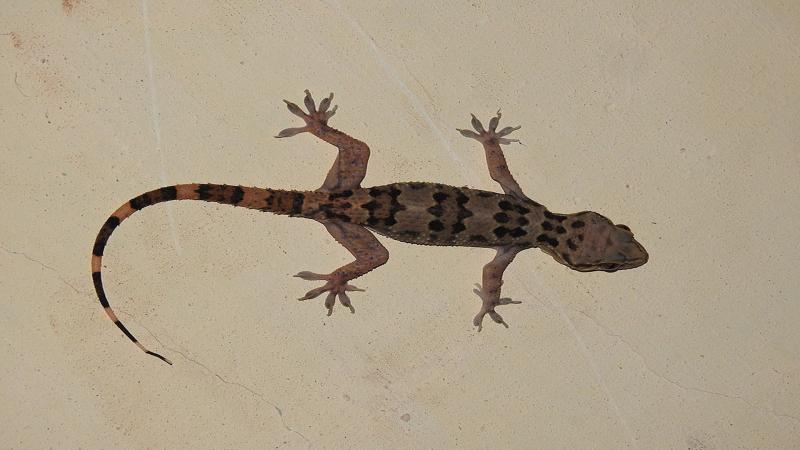
Researchers study the evolution and diversification of Hemidactylus Geckos in India
About 33 million years ago, the Earth saw a drastic climate change, resulting in the extinction of many animals and plants. This period, called the Eocene-Oligocene cooling period, was marked with reduction of temperature and formation of ice sheets at the poles. About 6 million years ago, the planet witnessed yet another turbulence in its climate, called the Late Miocene drying period, when the tides turned, and the temperature cooled. These phases of climate change, although detrimental to some animals and plants that lived then, have promoted the evolution and diversification of others. One such reptile is the house gecko, commonly seen on your walls and gardens.
In a series of studies, Dr Aparna Lajmi and Dr Praveen Karanth from the Indian Institute of Science, Bengaluru, have investigated how the Hemidactylus geckos, or leaf-toed geckos, evolved during the two periods of climate change. The first study, published in the journal Molecular Phylogenetics and Evolution looks at how changes in climate could have influenced the evolution of these lizards in Peninsular India. The other, published in the Journal of Evolutionary Biology, investigates how these lizards diversified morphologically. These studies were funded by the Department of Science and Technology (DST), the Rufford Small Grants Foundation and the Science and Engineering Research Board (SERB).
“Geckos are great model systems because they are easy to collect, usually abundant, and wonderful model systems to address questions on biogeography,” says Dr Lajmi, who has a general interest in reptiles. “I also wanted to learn molecular techniques to address evolutionary questions.”
The Hemidactylus geckos, which are members of the Gekkonidae family belonging to the genus Hemidactylus, are believed to have diversified into different species from a single ancestor. Over millions of years, the common ancestors may have exploited the changing environmental conditions like the sudden decrease of temperature or extreme aridity. In the northwestern part of the Indian subcontinent, aridity during the Late Miocene has resulted in the formation of open habitats and dry grasslands. These habitats are ideal for today’s Indian radiation of the Hemidactylus geckos.
The researchers collected specimens of 32 species from India belonging to the genus Hemidactylus. They extracted the DNA of these specimens and compared it with already-studied species, other Hemidactylus geckos believed to have a common ancestor, and three species from Cyrtodactylus or the bent-toed geckos. Since all these geckos mostly prefer dry habitats, the researchers used a tool to study morphological evolution on dry and wet habitats to determine when the dry habitat ancestor evolved.
The analysis found that the Hemidactylus geckos started to diversify about 39–32 million years ago, coinciding with the formation of the dry habitat during the Eocene-Oligocene cooling period and not during the Late Miocene. According to the researchers, this cooling period marks a global shift towards a cooler and drier climate. The study also found that the diversification of the geckos increased with the progression of this dry climate.
In the other study, the researchers conducted genetic analyses to understand the changes in the appearance and characters between the species. In India, there are two broad groups of these geckos—scansorial species that inhabit vertical surfaces, and terrestrial species that live on the ground. During the Late Miocene, grassland vegetation dominated the northern part of the Indian subcontinent, giving rise to open habitats and grasslands. While these areas do not contain the Hemidactylus geckos, these types of habitat are inhabited by terrestrial species today. The researchers hypothesised that the evolution of these species and their diversification happened during or after Late Miocene.
The researchers also included data from 249 preserved specimens from different museums, whose morphological measurements, like body size, shape, head size and shape of the toe pad, were assessed. The resulting measurements were averaged to obtain a mean value of each trait. The studied species were classified on two levels. First, they were divided into four groups based on the habitats they were found in, and then into terrestrial and scansorial species.
A detailed analysis further revealed that rupicolous geckos, a type of scansorial species which inhabit rocks, differed in their body size from terrestrial geckos. Further, scansorial species had a larger body size and toepad size than terrestrial species. The most ancestral lineage, the study found, was that of the scansorial species, and the terrestrial lineages evolved more recently and repeatedly. The earliest evolution of the latter occurred 19–12 million years ago, with the latest occurring sometime in the last 6 million years.
The findings of the studies show how differences in the morphology of geckos correspond to changes in their habitats. For example, for a scansorial species of a gecko, which has to cling on to a surface and move, it makes evolutionary sense to have larger toe pads. A theory suggested by the authors is that to avoid heavy competition within the scansorial species, terrestrial ones could have adapted to a new habitat. Further research is required to check if this theory is true. This diversification corresponds to the formation of dry habitats such as grasslands and open habitats. Further, the changes seen in the morphology are concurrent with that seen in climate.
As Dr Lajmi’s fascination for geckos continues, she hopes to “establish a research program in India that focuses on geckos, among other organisms.”
This article has been run past the researchers, whose work is covered, to ensure accuracy.






